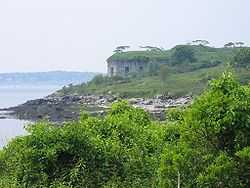House Island (Maine)

House Island is a private island in Portland Harbor in Casco Bay, Maine, United States. It is part of the City of Portland. The island is only accessible by boat. Public access is prohibited, except for an on request tour sanctioned by the island's owners. House Island includes three buildings on the east side and Fort Scammell on the west side. The buildings are used as summer residences. The island's name derives from the site of an early European house, believed that built by Capt. Christopher Levett, an English explorer of the region.
On June 21, 2012, the WSJ reported the island for sale for $4.9m.
Fort Scammell

Henry A. S. Dearborn built Fort Scammell on the island in 1808 as part of the national second system of fortifications. It was named after Alexander Scammell, Adjutant general of the Continental Army during the American Revolutionary War, who was killed in action during the Battle of Yorktown. The fort was designed for harbor defense, with cannon batteries designed to protect the main shipping channel into Portland harbor, along with Fort Preble. In the 1840s–1870s, as part of the national third system of fortifications, Fort Scammell was modernized. Thomas Lincoln Casey, known for his work on the Washington Monument rebuilt the fort in 1862 at the time of the American Civil War. Of all the forts in Casco Bay, Fort Scammell was the only fort to fire a shot and be fired upon in battle, in early August, 1813.
Immigration Quarantine Station
The island was later the site of an immigration quarantine station from 1907 to 1937, and was considered the 'Ellis Island of the North'. The quarantine station was busiest in the early 1920s, after the adoption of the Emergency Quota Act, which restricted the number of immigrants who could enter the country. In November 1923, the ships President Polk and George Washington were diverted from New York City to Portland, and 218 immigrants from those ships were quarantined at the station.
The island was considered "ideal" by immigration officials. A Grand Trunk Railway station was located at the docks in Portland, allowing easy rail access for immigrants arriving in Portland. Additionally, William Husband, Commissioner General of United States Immigration, said the whole island was secure and "The whole of House Island was available in that case, instead of those detained being obliged to go out under guard with only few patches of green grass upon which they might set foot, as at some other places."
The 1920 brick detention barracks have been demolished, but the original 1907 buildings remain, including the doctor's house, the detention barracks, and the quarantine hospital.
See also
References
- ^ Documentary History of the State of Maine, Containing the Farnham Papers, Mary Frances Farnham, Maine Historical Society, 1901
- ^ Maine's Casco Bay Islands: A Guide, Nance Trueworthy, David A. Tyler, Down East Books, 2007
- ^ http://live.wsj.com/video/private-island-in-maine-for-49-million/2E57B4C8-C60D-439C-9485-70D22F2C518D.html, June 21, 2012
- ^ "3000 Immigrants Due at Portland for November Quota," The Daily Kennebec Journal, October 30, 1923
- ^ "25 Years Ago Today," Portland Press Herald, November 5, 1948
- ^ "Immigration Head Loud in Praise of Pier at Portland," The Daily Kennebec Journal, November 28, 1923
- ^ ibid, The Daily Kennebec Journal, November 28, 1923
External links
Coordinates: 43°39′10″N 70°12′35″W / 43.65278°N 70.20972°W
| ||||||
| ||||||
| ||||||||||||||||||||||||||||||||||||||